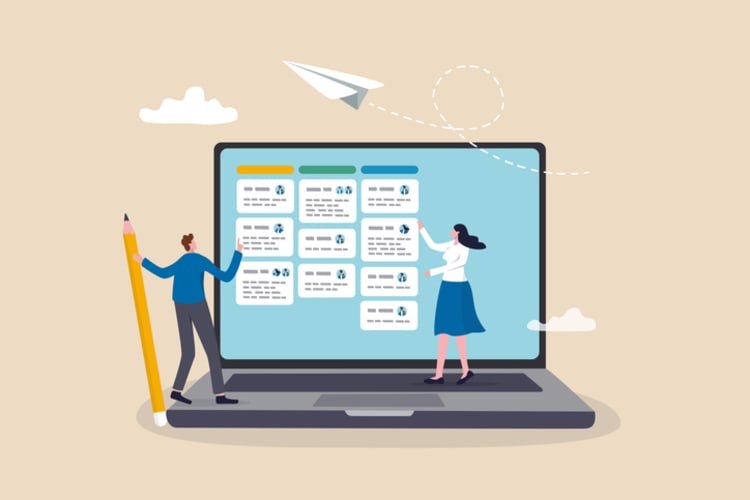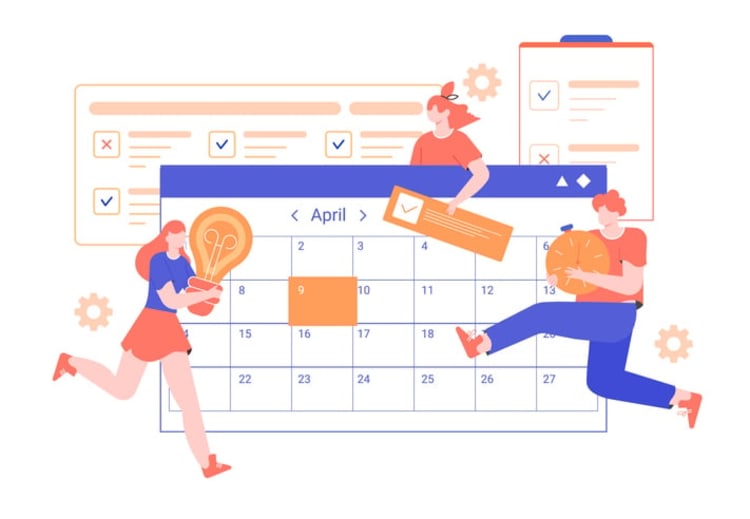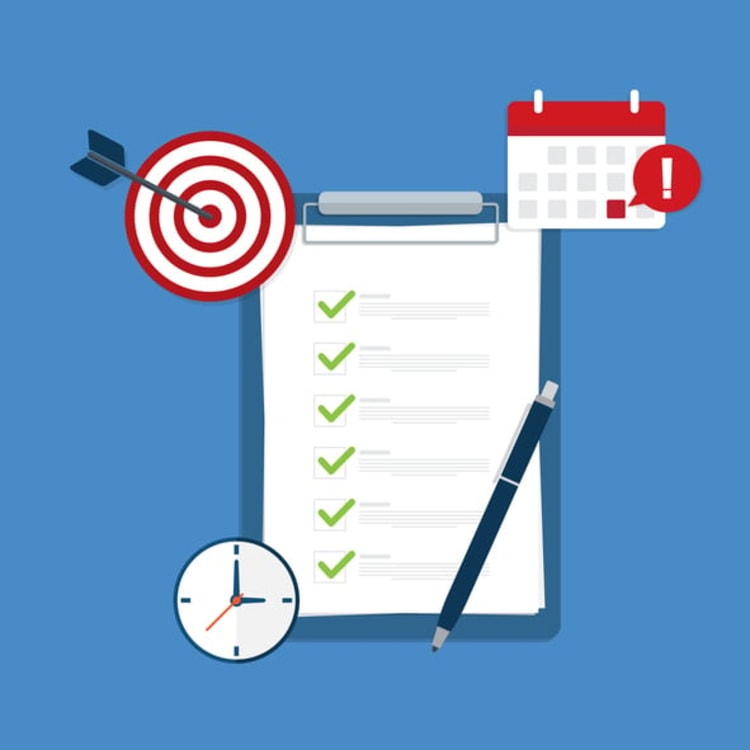In a fast-paced world where time is a precious commodity, effective task prioritization has become more crucial than ever. Are you tired of juggling countless tasks, missing deadlines, and feeling constantly overwhelmed? Say goodbye to all that! Discover nine practical methods on how to prioritize tasks and achieve your goals while maintaining a healthy work-life balance in 2024. Get ready to revolutionize the way you approach your to-do list, and unlock your full potential.
From breaking down complex tasks to utilizing powerful project management tools, this blog post will equip you with the strategies and techniques you need to stay organized, focused, and productive. Ready to level up your task management game? Let’s dive in!
Key takeaways
- Create a comprehensive task list to prioritize and stay focused.
- Break down complex tasks into achievable subtasks for efficient tracking.
- Utilize project management tools & team collaboration for successful prioritization & delegation.
Creating a comprehensive task list

The initial step to manage your workload and alleviate stress is to create a comprehensive task list. By including all tasks and breaking down complex ones, you can gain a clear understanding of your responsibilities and prioritize tasks based on importance, urgency, and the resources available. A well-organized task list not only helps you stay focused but also ensures you allocate time and effort efficiently.
So, how can you create a comprehensive task list that sets you up for success? Keep reading.
Breaking down complex tasks
Daunting projects become less overwhelming and easier to prioritize when you break complex tasks into smaller, manageable subtasks. This approach allows you to:
- Better understand the scope of your work
- Identify dependencies
- Allocate resources effectively
- Track progress more efficiently
For example, if you have a complex project that requires creating a website, break it down into manageable tasks like:
- designing
- coding
- testing
- launching the website
This approach can be applied to both daily tasks and weekly tasks, ensuring nothing falls through the cracks.
Adding details to tasks
Prioritization and scheduling can be significantly impacted when you add details like deadlines, effort, and importance to tasks. These details are particularly crucial for high-priority tasks, as they help you allocate resources and time effectively.
To accurately estimate the effort required for task completion, you can use project time-tracking software, like ClickUp, to gain insight into your effort estimates and refine them accordingly. This can be applied to both urgent tasks and those that may not be as time-sensitive, making sure you’re always on top of your deadlines.
Understanding importance and urgency

For effective task prioritization, it’s imperative to understand the difference between importance and urgency. Importance refers to a task’s value in relation to your goals and objectives, while urgency relates to the timeframe in which a task needs to be accomplished. Making this distinction can help you focus on the urgent and important tasks that truly matter and allocate your time and resources wisely.
To further aid in identifying and categorizing tasks based on their importance and urgency, you can use methods like the Eisenhower Matrix and the Most Important Tasks (MIT) method. These techniques can help you streamline your to-do list and ensure you’re always working on the most urgent tasks, which are crucial for your success.
The Eisenhower Matrix
The Eisenhower Matrix is an effective tool for separating tasks into four quadrants:
- Urgent and important
- Important but not urgent
- Urgent but not important
- Not urgent and not important
By categorizing your tasks into these quadrants, you can prioritize them accordingly, ensuring you’re always focused on the tasks that matter most.
The Most Important Tasks (MIT) method
The Most Important Tasks (MIT) method is a powerful productivity technique that enables you to:
- Identify and prioritize the most important tasks that need to be accomplished each day.
- Focus on the tasks that will have the greatest impact on your goals and overall productivity.
- Ensure that you’re making steady progress towards your objectives.
To use the MIT method, create a separate list of three tasks prioritized by importance to tackle first. This will help you stay focused on the tasks that will have the most positive impact on your goals and productivity, setting you up for success each day.
Prioritization techniques

Beyond comprehending the importance and urgency, numerous prioritization techniques can assist you in managing tasks more effectively and enhancing your productivity. These include the Eat the Frog method, the ABCDE Method, and Time Blocking.
Each of these techniques offers a unique approach to task prioritization, allowing you to find the one that works best for you. By incorporating these methods into your daily routine, you can ensure that you’re consistently working on high-priority tasks, staying organized, and maximizing your productivity.
Eat the Frog
The Eat the Frog method suggests dealing with the most important task early in the morning, leveraging your peak energy and focus. By completing this task early on, you can reduce stress and maintain focus for the rest of the day.
This technique is based on the quote by Mark Twain, “Eat a live frog first thing in the morning and nothing worse will happen to you the rest of the day.” So, make it a habit to “eat the frog” every morning and watch your productivity soar.
ABCDE Method
The ABCDE Method is another excellent technique for prioritizing tasks. It involves grading tasks from A (very important) to E (eliminate whenever possible) and tackling them accordingly. By focusing on A and B tasks first, you can make the most of your time and ensure that you’re always working on the most important tasks.
To put the ABCDE method into practice, start by creating a prioritized task list, and then assign a letter grade to each task based on its importance and urgency. This will help you stay organized and ensure that you’re always focused on what truly matters.
Time Blocking
Time Blocking is a fantastic technique for managing tasks and maximizing productivity. It involves breaking down tasks into manageable chunks and assigning them to specific blocks of time, allowing you to work more efficiently and get the most out of your day.
By scheduling focused work activities in uninterrupted blocks with breaks in between, you can maintain your concentration and energy levels throughout the day. Time Blocking can be easily customized to fit your individual work style and preferences, making it an incredibly versatile and effective prioritization technique.
Balancing workload and personal life

For overall well-being, achieving a balance between workload and personal life is significant. By recognizing your productivity limits and delegating or reassigning tasks when necessary, you can maintain a healthy work-life balance while still achieving your professional goals.
Whether you’re managing a team or working independently, it’s crucial to stay mindful of the balance between work and personal life. This way, you can avoid burnout, maintain your motivation, and continue to perform at your best.
Recognizing productivity limits
To set realistic goals and avoid burnout, it’s vital to recognize personal productivity limits. By understanding factors such as:
- physical and mental capacity
- skill level
- time constraints
- external distractions
You can recognize your limits and effectively manage and prioritize tasks.
Delegating and reassigning tasks
Delegating and reassigning tasks is an important aspect of workload management. By transferring the authority and accountability for completing a task to other individuals or teams, you can optimize the use of resources and get more done.
Effectively delegating and reassigning tasks involves:
- Identifying tasks that can be delegated
- Selecting the right person or team to delegate the task to
- Providing clear instructions and expectations
- Monitoring the progress of the task
This way, you can prioritize effectively, focusing on high-priority tasks, while ensuring that every one task, including prioritize your tasks and other tasks of lower priority, is completed efficiently.
Adapting to changing priorities

Given the dynamic nature of today’s world, the ability to adapt to changing priorities is key for effective task management. Unexpected events can alter task priorities, making it essential to regularly review and adjust your priorities accordingly.
By being flexible and adaptable in the face of unexpected events, you can minimize stress and maintain your focus on the tasks that are most important for achieving your goals and objectives.
Regular review and adjustment
An integral part of effective task prioritization is the regular review and adjustment of priorities. This process involves assessing the progress, performance, and outcomes of your tasks, and making necessary adjustments or improvements based on the findings.
To ensure you stay on track, it’s recommended to review task priorities daily or weekly. This will help you stay focused, minimize time waste, and ensure you’re always working on the tasks that truly matter.
Flexibility and the sunk cost fallacy
Flexibility and awareness of the sunk cost fallacy are important for making informed decisions and changing priorities when necessary. People are often fooled by the sunk cost fallacy. This psychological effect leads them to commit more resources even though it may no longer be rational to do so, as the time and effort that has already been spent is the primary factor for them.
By recognizing the sunk cost fallacy and being flexible in the face of changing priorities, you can prevent yourself from making decisions based on the amount of time and effort you have already invested in a task, and instead focus on the potential benefits of shifting your priorities.
Utilizing project management tools

For streamlining task prioritization, tracking, and team collaboration, project management tools can be a game-changer. These tools offer a centralized platform to:
- Organize tasks
- Set priorities
- Track deadlines
- Collaborate with teams
This leads to increased productivity and better time management.
By leveraging the power of project management tools, you can stay organized, focused, and productive, ensuring that you’re always working on what matters most to you and your team.
Task tracking and progress monitoring
Features in project management tools, like task tracking and progress monitoring, can assist in staying organized and meeting deadlines. By providing an overview of your tasks and their status, these tools enable you to monitor progress, anticipate potential problems, and identify areas where you can continue to improve.
Tools like Asana, Kumospace, Trello, Jira, and Basecamp can help you keep track of tasks and monitor progress effectively, ensuring that you’re always on top of your deadlines and accomplishing your goals.
Team collaboration and communication
For successful task prioritization and delegation, team collaboration and communication play a crucial role. Project management tools offer features such as resource allocation, task comments, and document collaboration that facilitate teamwork and ensure that tasks are completed efficiently and on time.
By utilizing these collaboration and communication features, you can foster a culture of teamwork, ensure that your team members are working on the right tasks, and ultimately achieve your goals more effectively.
Navigating Task Management with Kumospace
Elevate your task prioritization strategies by incorporating Kumospace into your project management approach. This spatial technology platform transforms virtual interactions, enabling teams to discuss, strategize, and collaborate within an immersive digital environment.
Envision utilizing Kumospace for team meetings to prioritize tasks: members can move through various virtual spaces, diving into focused discussions on specific tasks, and seamlessly collaborating on prioritization strategies. This interactive approach not only enhances engagement but also adds a tangible, visual layer to task management discussions, aiding in clear, comprehensive planning and prioritization amidst the digital workspace.
Summary
In conclusion, mastering the art of task prioritization is essential for success in today’s fast-paced world. By creating a comprehensive task list, understanding the difference between importance and urgency, adopting various prioritization techniques, balancing workload and personal life, adapting to changing priorities, and utilizing project management tools, you can revolutionize the way you approach your to-do list and unlock your full potential. It’s time to take control of your tasks and achieve your goals, one prioritized task at a time.
FAQs
To prioritize tasks effectively, create a comprehensive task list and identify deadlines, then assess importance, urgency, effort, and resources required for each. Prioritize the most urgent tasks, accounting for dependencies and breaking down complex tasks as necessary.
Your first priority should be to focus on important and urgent tasks, since these take precedence. Evaluate estimated time for completion and begin the task that will require more effort. Delegate any urgent but not important tasks and avoid anything that is neither urgent nor important.
Critical tasks are those with close deadlines or high importance, while high priority tasks are of high value but not urgent. Medium-priority tasks are important in the long-term, while low priority tasks are non-urgent and low in value.
Make sure you take time for yourself, set realistic goals and delegate tasks when you can - this way you'll be able to balance your workload and personal life.
Regularly review and adjust your priorities to stay on top, and be flexible to ensure you complete your tasks efficiently. Be open to change, and you'll adapt just fine!





